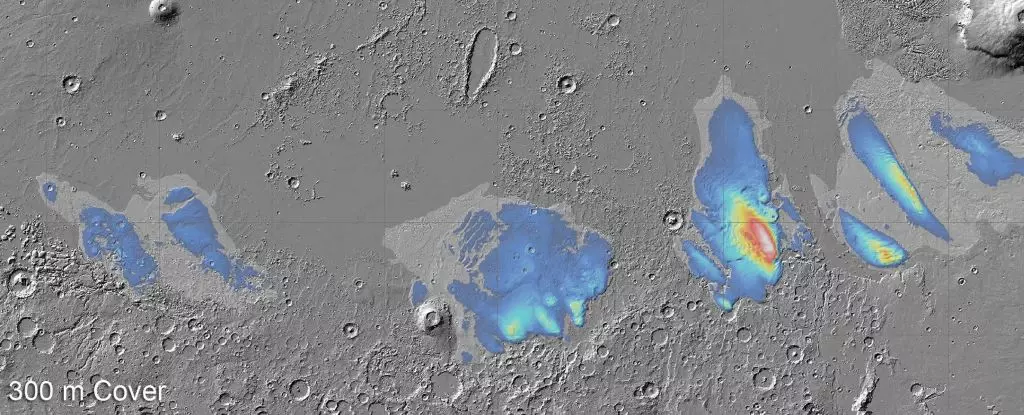The surface of Mars has always been perceived as barren and devoid of life. However, recent findings suggest that the red planet is concealing an abundance of secrets that have long remained hidden from human observations. Thanks to advanced technology, scientists have now discovered what appears to be giant layered slabs of buried water ice in the Medusae Fossae Formation region on the Martian equator. These ice deposits, several kilometers thick, represent the largest concentration of water ever found around Mars’ middle. This remarkable revelation challenges our previous notions of the planet’s dry nature and raises the possibility of a watery history on Mars.
The Medusae Fossae Formation stretches for approximately 5,000 kilometers along the Martian equator and separates the lowlands in the north from the cratered highlands in the south. The vast and mysterious deposits that constitute this formation have puzzled scientists, who have long sought to comprehend their origin and composition. In 2007, radar data collected from the region revealed the presence of buried material, but the nature of this material remained unclear. The possibilities ranged from volcanic material to sediment from past wetter periods or even the intriguing prospect of water ice.
To gain a deeper understanding of the mysterious Medusae Fossae Formation, researchers embarked on a new radar survey, armed with advanced tools for data analysis. The results surpassed expectations, revealing the deposits to be even thicker than previously estimated. These layers of ice extend up to 3.7 kilometers below the surface, resembling the signals emitted by the ice-rich polar caps of Mars. The consistency of the radar signals with what is known about layered ice further strengthens the evidence for the presence of extensive buried water ice within the formation.
The Significance and Implications
The discovery of massive water ice deposits within the Medusae Fossae Formation has profound implications for our understanding of Mars’ climate history. The presence of such a substantial water reservoir challenges the notion of a completely arid planet and prompts questions about the disappearance of water on Mars. The fate of the water that once flowed on the Martian surface remains a mystery. Did it escape into space as vapor, or is it concealed deep within the planet where it eludes our detection? Resolving these questions is crucial not only for scientific curiosity but also for future human missions to Mars.
Water is a vital resource for human survival, and its presence on Mars would significantly enhance the viability of future missions. If water already exists on the planet, it would serve as a potential resource for sustenance and hydration, minimizing the amount that needs to be transported from Earth. Unfortunately, the water ice within the Medusae Fossae Formation is inaccessible, buried beneath several hundred meters of Martian dust. However, this discovery kindles hope that water may be hiding elsewhere on Mars, waiting to be discovered and utilized by future astronauts.
Unveiling Mars’ Enigmatic History
The newfound information about the massive buried water ice deposits in the Medusae Fossae Formation offers a glimpse into Mars’ enigmatic past. Determining when these ice deposits formed and what Mars was like during that time are just a few of the questions it raises. By shedding light on Mars’ climate history, this discovery provides valuable insights into the transformation of the planet into its present state. Scientists now have an opportunity to broaden their knowledge of Mars’ clandestine past, offering new perspectives that could potentially reshape our understanding of the red planet.
The revelation of extensive buried water ice within the Medusae Fossae Formation marks a significant milestone in our exploration of Mars. Contrary to the conventional belief of a dry and inhospitable planet, these findings challenge our perceptions and ignite further curiosity about the possibility of a watery Martian past. Unlocking the secrets of Mars’ water distribution and history is not only important for scientific discovery but also for the future viability of human missions to the red planet. As technology advances and our understanding deepens, Mars continues to reveal its hidden secrets, continually captivating and inspiring scientists and space enthusiasts alike.


Leave a Reply